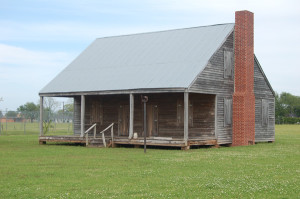
It was in 1852 that Edwin Epps, Northup’s owner, decided to build his house, and in doing so, Epps hired architect and carpenter Samuel Bass. Because Northup had carpentry experience, he helped Bass with the house, and the two eventually forged a friendship. As a result, Bass agreed to write a letter to those in Northup’s home state of New York to inform them of his plight, thereby setting in motion Northup’s return home. Eventually, Epps was told of Northup’s status as a free man inside the very same house Northup helped build. Without the house, Northup would never have met Bass, and likely would have remained a lifelong slave in Central Louisiana.
“The Epps House is an important reminder of a tragic episode that cost Solomon Northup twelve years of his freedom, but gave him the opportunity to tell an important story about slavery from a very rare perspective,” says LSUA history professor Dr. Jerry Sanson. Today, a reconditioned Epps House sits on the LSUA campus. The house, which was first constructed in Avoyelles Parish before being moved to Bunkie and then finally to LSUA, is being turned into a permanent exhibit for visitors to learn more about Northup as well as life during this era.
Epps House: Solomon Northrup’s Gateway to Freedom is set to open to the public on Thursday, November 14th. A ribbon cutting will be held at 11:00am and the public is invited to attend. The new exhibit will have information dedicated not only to Solomon Northup and the Northup Trail, but also to former LSUA history professor Dr. Sue Eakin. Dr. Eakin dedicated her career to finding out more about Northup and plantation life after discovering the book “Twelve Years a Slave” while a young child. Additionally, there will be folk art from the period and a digital display where visitors can listen to some of the music written by Northup.










